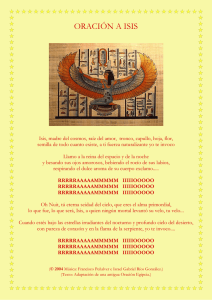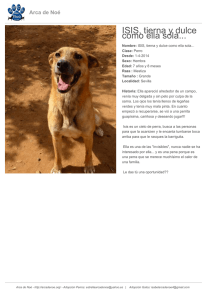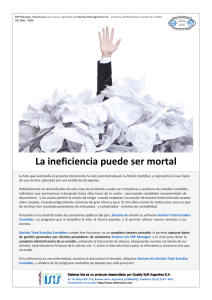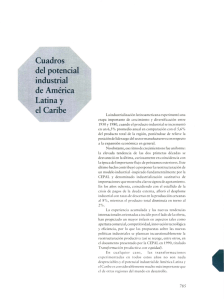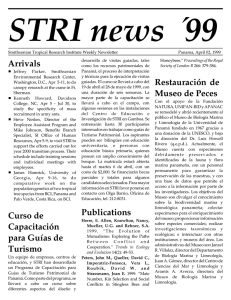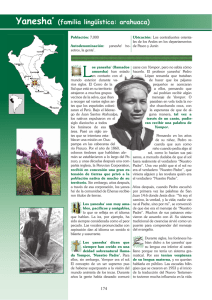why no poop in garden? - Smithsonian Tropical Research Institute
Anuncio
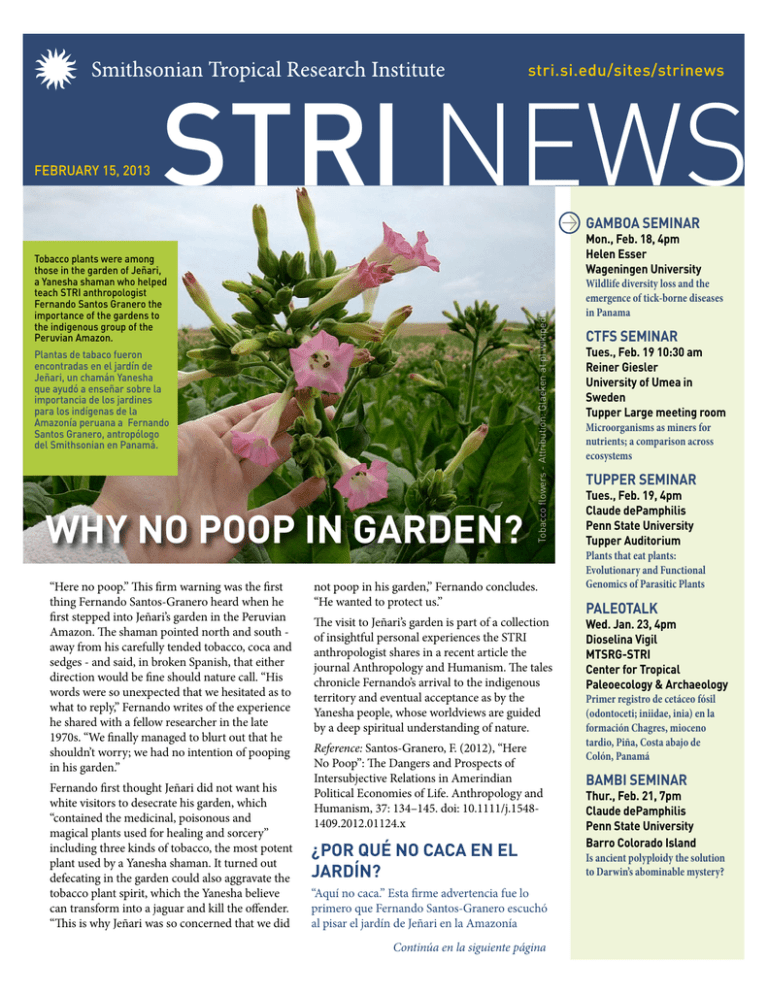
STRI NEWS stri.si.edu/sites/strinews FEBRUARY 15, 2013 GAMBOA SEMINAR Tobacco plants were among those in the garden of Jeñari, a Yanesha shaman who helped teach STRI anthropologist Fernando Santos Granero the importance of the gardens to the indigenous group of the Peruvian Amazon. Plantas de tabaco fueron encontradas en el jardín de Jeñari, un chamán Yanesha que ayudó a enseñar sobre la importancia de los jardines para los indígenas de la Amazonía peruana a Fernando Santos Granero, antropólogo del Smithsonian en Panamá. WHY NO POOP IN GARDEN? “Here no poop.” This firm warning was the first thing Fernando Santos-Granero heard when he first stepped into Jeñari’s garden in the Peruvian Amazon. The shaman pointed north and south away from his carefully tended tobacco, coca and sedges - and said, in broken Spanish, that either direction would be fine should nature call. “His words were so unexpected that we hesitated as to what to reply,” Fernando writes of the experience he shared with a fellow researcher in the late 1970s. “We finally managed to blurt out that he shouldn’t worry; we had no intention of pooping in his garden.” Fernando first thought Jeñari did not want his white visitors to desecrate his garden, which “contained the medicinal, poisonous and magical plants used for healing and sorcery” including three kinds of tobacco, the most potent plant used by a Yanesha shaman. It turned out defecating in the garden could also aggravate the tobacco plant spirit, which the Yanesha believe can transform into a jaguar and kill the offender. “This is why Jeñari was so concerned that we did Tobacco flowers - Attribution: Glaeken at pl.wikipedia Mon., Feb. 18, 4pm Helen Esser Wageningen University not poop in his garden,” Fernando concludes. “He wanted to protect us.” The visit to Jeñari’s garden is part of a collection of insightful personal experiences the STRI anthropologist shares in a recent article the journal Anthropology and Humanism. The tales chronicle Fernando’s arrival to the indigenous territory and eventual acceptance as by the Yanesha people, whose worldviews are guided by a deep spiritual understanding of nature. Reference: Santos-Granero, F. (2012), “Here No Poop”: The Dangers and Prospects of Intersubjective Relations in Amerindian Political Economies of Life. Anthropology and Humanism, 37: 134–145. doi: 10.1111/j.15481409.2012.01124.x ¿POR QUÉ NO CACA EN EL JARDÍN? “Aquí no caca.” Esta firme advertencia fue lo primero que Fernando Santos-Granero escuchó al pisar el jardín de Jeñari en la Amazonía Continúa en la siguiente página Wildlife diversity loss and the emergence of tick-borne diseases in Panama CTFS SEMINAR Tues., Feb. 19 10:30 am Reiner Giesler University of Umea in Sweden Tupper Large meeting room Microorganisms as miners for nutrients; a comparison across ecosystems TUPPER SEMINAR Tues., Feb. 19, 4pm Claude dePamphilis Penn State University Tupper Auditorium Plants that eat plants: Evolutionary and Functional Genomics of Parasitic Plants PALEOTALK Wed. Jan. 23, 4pm Dioselina Vigil MTSRG-STRI Center for Tropical Paleoecology & Archaeology Primer registro de cetáceo fósil (odontoceti; iniidae, inia) en la formación Chagres, mioceno tardio, Piña, Costa abajo de Colón, Panamá BAMBI SEMINAR Thur., Feb. 21, 7pm Claude dePamphilis Penn State University Barro Colorado Island Is ancient polyploidy the solution to Darwin’s abominable mystery? peruana. El chamán señaló hacia el norte y hacia el sur, lejos de sus bien cuidadas plantas de tabaco, coca y juncos. Luego dijo en su español machacado que cualquiera de las direcciones señaladas estaban bien si necesitaban atender al llamado de la naturaleza. “Sus palabras fueron tan inesperadas que no supimos qué contestarle,” describe Fernando sobre la experiencia compartida junto con un compañero investigador al final de los años 70. “Finalmente le dijimos que no se preocupara, que no teníamos intenciones de defecar en su jardín.” Inicialmente Fernando pensó que Jeñari no quería que los visitantes profanaran su jardín, el cual “contenía plantas medicinales, venenosas y mágicas utilizadas para curar y para la hechicería” incluyendo tres tipos de tabaco, la planta más potente utilizada por el chamán Yanesha. Resulta que si alguien defeca en el jardín también puede despertar la ira del espíritu de la planta de tabaco, el cual los Yanesha creen que puede convertirse en un jaguar y matar al infractor. “Era por eso que Jeñari estaba tan preocupado de que no defecaramos en su jardín,” concluye Fernando. “Quería protegernos.” La visita al jardín de Jeñari es parte de una colección de interesantes experiencias personales que el antropólogo del Smithsonian en Panamá comparte en un reciente artículo de la publicación Anthropology and Humanism. Las historias son crónicas de la llegada de Fernando al territorio indígena y la eventual aceptación por el pueblo Yanesha, cuya cosmovisión es guiada por una profunda comprensión espiritual de la naturaleza. Referencia: Santos-Granero, F. (2012), “Here No Poop”: The Dangers and Prospects of Intersubjective Relations in Amerindian Political Economies of Life. Anthropology and Humanism, 37: 134–145. doi: 10.1111/j.1548-1409.2012.01124.x As part of the Five-Year STRI-ARAP Interagency Cooperation Agreement, experience exchange programs are developed with different programs that both institutions develop. In this ocation CEOs chaired by ARAP General SubAdminsitrator visited BCI to learn about the operation, public and scientific programs developed by STRI. Como parte del Convenio Quinquenal de Cooperación Interinstitucional STRI-ARAP se llevan a cabo programas de intercambio de experiencias con los diferentes programas que desarrollan ambas instituciones. En esta ocasión los Directores Generales presididos por la SubAdminsitradora General de la ARAP visitaron BCI para conocer sobre la operación, programa público y científico que desarrolla STRI. Staff anthropologist Fernando Santos-Granero displays indigenous ornaments in his office at the Tupper Center in Panama. One of his latest publications explores lessons learned with Yanesha people of the Peruvian Amazon. Fernando Santos-Granero, antropólogo del Smithsonian en Panamá muestra unos ornamentos indígenas en su oficina del Centro Tupper en Panamá. Una de sus más recientes publicaciones explora las lecciones aprendidas con el pueblo Yanesha en la Amazonía peruana. Por más de 20 años, Isis Estribí ha colaborado en diferentes divisiones de STRI, como la Oficina de Servicios de Visitantes y la Oficina Administrativa de Apoyo Científico For over 20 years, Isis Estribí has collaborated in different divisions of STRI, like the Visitor’s Services Office and the office of the Associate Director for Science Administration ¡HASTA LUEGO, ISIS! STRI owes much of its success to our employees who work behind the scenes to facilitate the research process, generously offering their time to achieve our mission, growing with STRI, just as they help STRI to grow. Today we would like to pay tribute to one of the people who played an essential role at STRI, someone who decided to join the STRI family more than 20 years ago. Always jovial, Isis Estribí has offered her many talents to STRI in several different departments. Isis will bid farewell to STRI from the Office of Scientific Support (ADSA), a department where she continues her history of being instrumental and where her work impacts every scientist who comes to STRI in Panama and leaves with the satisfaction of achieving what s/he aimed to accomplish. We will definitely miss her. On one hand it will be difficult to let her go but on the other hand we know that she deserves time to pursue her personal plans. We wish her the best of health and wonderful opportunities in life. Always remember that you were part of STRI’s success! ¡HASTA LUEGO, ISIS! Gran parte del éxito de STRI se debe a sus colaboradores, quienes trabajan detrás de bastidores para facilitar la ciencia, ofrecen generosamente su tiempo para cumplir con nuestra misión y quienes han crecido con STRI al igual que STRI con ellos. Hoy queremos rendir homenaje a una de esas piezas claves de este instituto. Alguien quien hace más de 20 años decidió unirse a esta familia para apoyar a STRI en su valiosa misión. Siempre jovial, Isis Estribí Isis ha brindado sus múltiples talentos a STRI a través de su labor en diferentes departamentos. Isis le dirá hasta luego a STRI desde la oficina administrativa de apoyo científico (ADSA), un departamento en el que Isis continuó su tradición de ser instrumental con su profesionalismo; una división en la que su trabajo se ve reflejado en cada científico que viene a Panamá y parte con la satisfacción del deber cumplido. Isis Estribi and Xenia Saavedra “SUPERWOMAN PALES NEXT TO ISIS…” - MARÍA LEONE “I am impressed by her excellent manner and mastery of spoken English. She is the ideal person to work with students and fellows.” - Georgina De Alba “ISIS IS GENEROUS AND ALWAYS THERE WHEN YOU NEED HER…HER JOVIALITY IS EXTRAORDINARY.” - ORIS ACEVEDO “Isis stands out for her simplicity and strength under pressure. Her generosity is admirable.” - Xenia Saavedra “MANY TIMES WE HAD TO RESOLVE PROBLEMS [IN THE VISITORS’ OFFICE]. WITH HER FRIENDLY SMILE AND HER HELPFUL DISPOSITION HER INITIATIVE AND CREATIVITY, ISIS WAS INDISPENSABLE FOR DEALING WITH SOME OF THE MORE UNUSUAL TASKS WE WERE FACED WITH.” - GLORIA MAGGIORI “Isis was one of the first people who welcomed me when I started my internship at STRI. She guided me through the process. I’ll always remember Isis for her sweetness and helpful disposition. Through the years, Isis has not only been a guide for me, she’s been a great co-worker, and above all, a close friend.” - Oris Sanjur Definitivamente ya la extrañamos. Por una parte se nos hace difícil dejarla ir, pero por otra sabemos que tiene merecido su tiempo para sus planes personales. A ella le deseamos mucha salud y grandes oportunidades en su vida privada. Isis, en STRI quedan tus amigos quienes te echarán de menos. ¡Siempre, siempre recuerda que eres parte del éxito de STRI! “La mujer maravilla queda chica al lado de Isis…” - María Leone “ME IMPRESIONARON SUS EXCELENTES MANERAS Y LO BIEN QUE HABLABA EL INGLÉS. PENSÉ QUE SERÍA IDEAL PARA TRABAJAR CON ESTUDIANTES Y BECARIOS. “ - GEORGINA DE ALBA “Isis es desprendida y siempre esta para el que necesite ayuda… Su jovialidad es extraordinaria.” - Oris Acevedo “ISIS SE DESTACA POR SU SENCILLEZ, POR SU FORTALEZA. TIENE UN SENTIDO DE DESPRENDIMIENTO ADMIRABLE.” - XENIA SAAVEDRA “Muchas veces tuvimos que resolver problemas [en la oficina de visitantes]. Con su sonrisa amable, su disposición para ayudar, su iniciativa y creatividad, Isis se convirtió en un ente indispensable para poder resolver estas tareas no tan comunes.” - Gloria Maggiori “ISIS FUE UNA DE LAS PRIMERA PERSONAS QUE ME RECIBIÓ CUANDO INICIÉ MI PASANTÍA EN STRI. ELLA ME GUIÓ POR EL PROCESO. SIEMPRE RECUERDO A ISIS POR SU DULZURA Y SU ÁNIMO DE AYUDAR. A TRAVÉS DE LOS AÑOS, ISIS HA SIDO PARA MI NO SOLO UNA GUÍA, SINO UNA GRAN COLABORADORA Y SOBRE TODO UNA AMIGA ENTRAÑABLE.” - ORIS SANJUR POLLEN WHISPERER As one of only a few modern pollen experts in Latin America, Enrique Moreno’s time and talent are in great demand. With staff scientists Dave Roubik, Carlos Jaramillo and Dolores Piperno, this biological technician at STRI’s Center for Tropical Paleoecology and Archaeology discovers which flowers bees pollinate, what grew in the first tropical forests and how corn was domesticated—pouring over microscope slides dotted with tiny pollen grains. But his own 18-year pollen collection comprises the longest aerial pollen record available for the tropical Americas. Nearly 20 years ago, Enrique helped PhD candidate Mark Bush install pollen traps in the forest-dynamics plot on Barro Colorado Island. When Mark left, Enrique continued and installed additional traps on the BCI tower and the Sherman canopy crane. “I wanted to know how El Niño droughts and La Niña rains (ENSO) affect tree reproduction.” Samples piled up in coldstorage until Surangi Punyasena, from the University of Illinois Urbana-Champagne with Dave and Enrique’s Pollen and Spores of BCI in hand, devised a computerized pollen counting system. Soon the relationship between climate and tropical tree reproduction will be revealed. EL ENCANTADOR DE POLEN Como uno de los pocos expertos en polen moderno en América Latina, el tiempo y talento de Enrique Moreno tienen gran demanda. Junto a los científicos permanentes Dave Roubik, Carlos Jaramillo y Dolores Piperno, este técnico biológico en el Centro de Paleoecología y Antropología Tropical del Smithsonian en Panamá descubre qué flores son polinizadas por las abejas, qué creció en los primeros bosques tropicales y cómo se domesticó el maíz, al pasar horas sobre los portaobjetos de su microscopio espolvoreados con pequeños granos de polen. Su colección personal de 18 años comprende el registro más extenso de polen aéreo disponible para la América tropical. Hace casi 20 años, Enrique ayudó al candidato a doctorado Mark Bush a instalar plantas de polen en la parcela de dinámica de bosque en la Isla Barro Colorado. Luego de que Mark partió, Enrique continuó e instaló plantas adicionales en la torre de BCI y la torre del dosel de Sherman. “Quería saber cómo las sequías de El Niño y las lluvias de La Niña afectan la reproducción de los árboles.” Las muestras se acumulaban en una cámara frigorífica hasta que Surangi Punyasena de la Universidad de Illinois UrbanaChampagne con el informe de Dave y Enrique, Pollen and Spores of BCI a mano, creó un sistema computarizado para contar polen. Pronto se revelará la relación entre el clima y la reproducción de los árboles tropicales. ARRIVALS Arrivals DEPARTURES Departures Fran Zakutansky, Dorothy Stradford and Katrina Macht Montclair State University Barro Colorado Island Mammal Census Barro Colorado Island Gabriel Jácome To Panama City To attend administrative matters and meetings Yann Gager and Matthieu Menage To La Selva, Costa Rica To attend annual OTS Science Committee meeting University of Konstanz Costs and benefits of sociality in bats - looking at the example of a tropical species with a temperate-like social structure Gamboa Tobias Messmer University of Bern Calcium cycling in the soil-fig-bat compartment of a neotropical rain forest on spatially heterogeneous substrate Barro Colorado Island Steve Paton Suzanne Lao To Quito, Ecuador To work on Yasuni database in order to confederate the TEAM data with the CTFS data. Lisa Barnett To Panama City Smithsonian Women’s Committee Visit Janet Foley University of California – Davis Tropical vertebrate diversity loss and the emergence of tickborne diseases: a pilot to develop SIGEO for monitoring wildlife and diseases Gamboa Timothy Agin University of Illinois Urbana-Champaign Monitoring the dynamics of avian communities and population in Central Panama Panama Ioana Chiver The role of female song in territorial defense in a tropical species Gamboa SAVE THE DATE The Office of Academic Programs proudly announces the 2013 FELLOWS’ SYMPOSIUM Friday, March 15 STRI fellows and interns are invited to submit a title and a short abstract (150 words) by February 15 to give a talk or present a poster PUBLICATIONS Pauly, A., Pedro, S. R. M., Rasmussen, C. and Roubik, D. W. 2013. Stingless bees (Hymenoptera: Apoidea: Meliponini) of French Guiana. In: Vit, P., Pedro, S., R.M. and R., David W., . New York: Springer, pp.87-98. Suselbeek, L., Jansen, P. A., Prins, H. H. T. and Steele, M. A. 2013. Tracking rodent-dispersed large seeds with Passive Integrated Transponder (PIT) tags. Methods in Ecology and Evolution, doi:10.1111/2041-210X.12027 Liu, X., Swenson, N. G., Zhang and J., Ma, K. The environment and space, not phylogeny, determine trait dispersion in a subtropical forest. Functional Ecology, doi: 10.1111/1365-2435.12018 Muscarella, R., Uriarte, M., Forero-Montaña, J., Comita, L. S., Swenson, N. G., Thompson, J., Nytch, C. J., Jonckheere I. and Zimmerman, J. K. Lifehistory trade-offs during the seed-to-seedling transition in a subtropical wet forest community, Journal of Ecology, doi: 10.1111/1365-2745.12027 Goheen, J. R., Palmer, T. M. Charles, G. K. Helgen, K. M., Kinyua, S. N., Maclean, J. E., Turner, B.J., Young, H. S., and Pringle, R. M. Piecewise disassembly of a large-herbivore community across a rainfall gradient: The UHURU Experiment, PLOS ONE, doi: 10.1371/journal.pone.0055192 Basset, Y., Cizek, L., Cuénoud, P., Didham, R. K., Guilhaumon, F., Olivier M., Novotny, Raphael K., Ødegaard, F., Roslin, T., Schmidl, J., Tishechkin, A. K., Winchester, N. N., Roubik, D. W., Aberlenc, H., Bail, J., Barrios, H., Bridle, J. R., Castaño-Meneses, G., Corbara, B., Curletti, G., Duarte da Rocha, W., De Bakker, D., Delabie, J. H. C., Dejean, A., Fagan, L. L., Floren, A., Kitching, R. L., Medianero, E., Miller, S. E., Gama de Oliveira, E., Orivel, J., Pollet, M., Rapp, M., Ribeiro, S. P., Roisin, Y., Schmidt, J. B., Sørensen, L. and Leponce, M. Arthropod diversity in a tropical forest, Science, doi: 10.1126/ science.1226727 Adriana Bilgray | [email protected] SUPPORT YOUR FRIENDS AND COLLEAGUES. MARK THE EVENT ON YOUR CALENDAR! Questions/comments Preguntas/comentarios [email protected]
